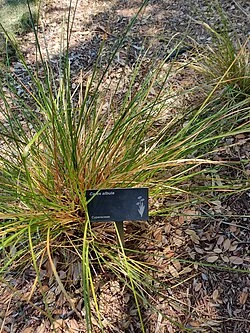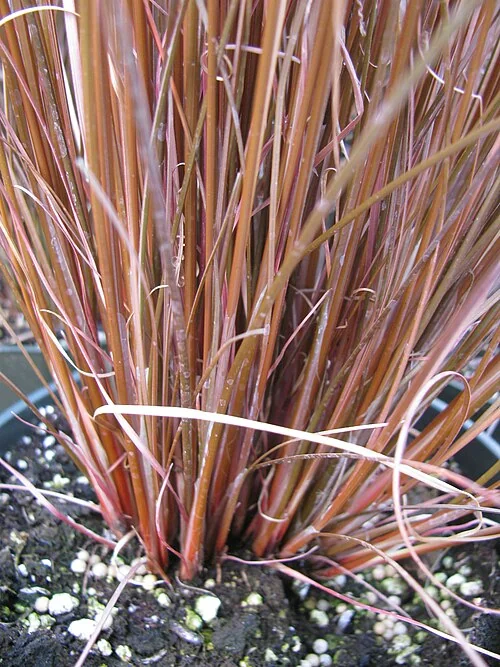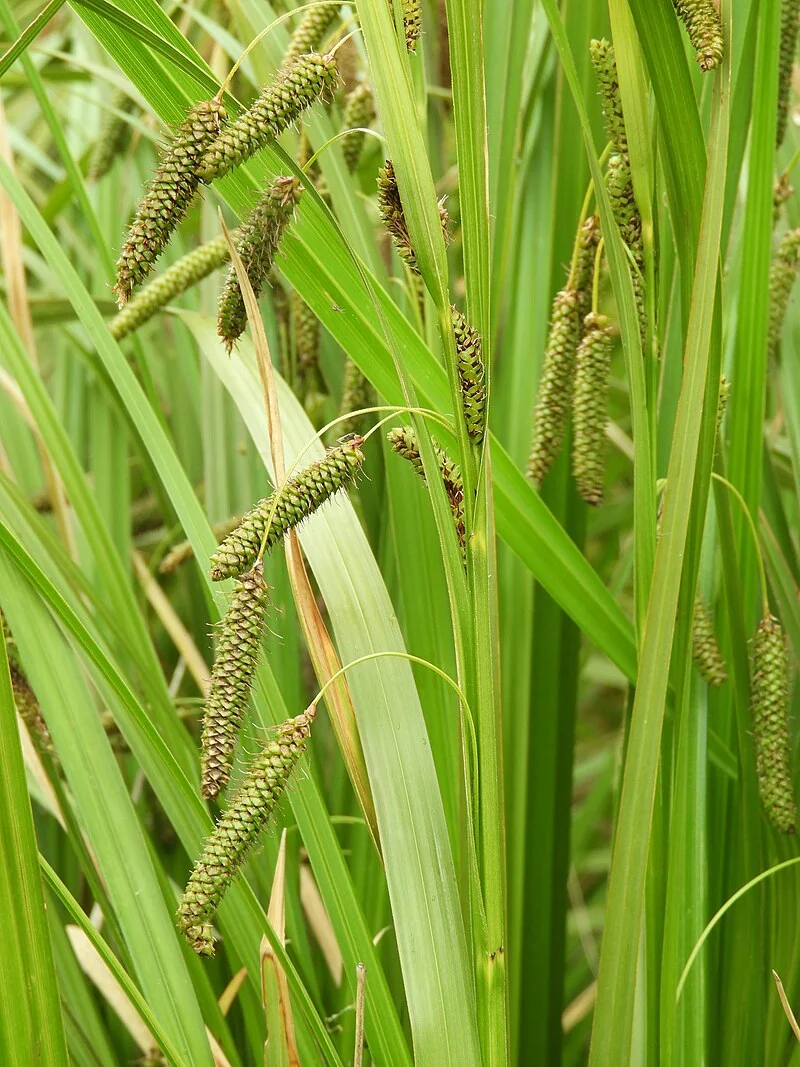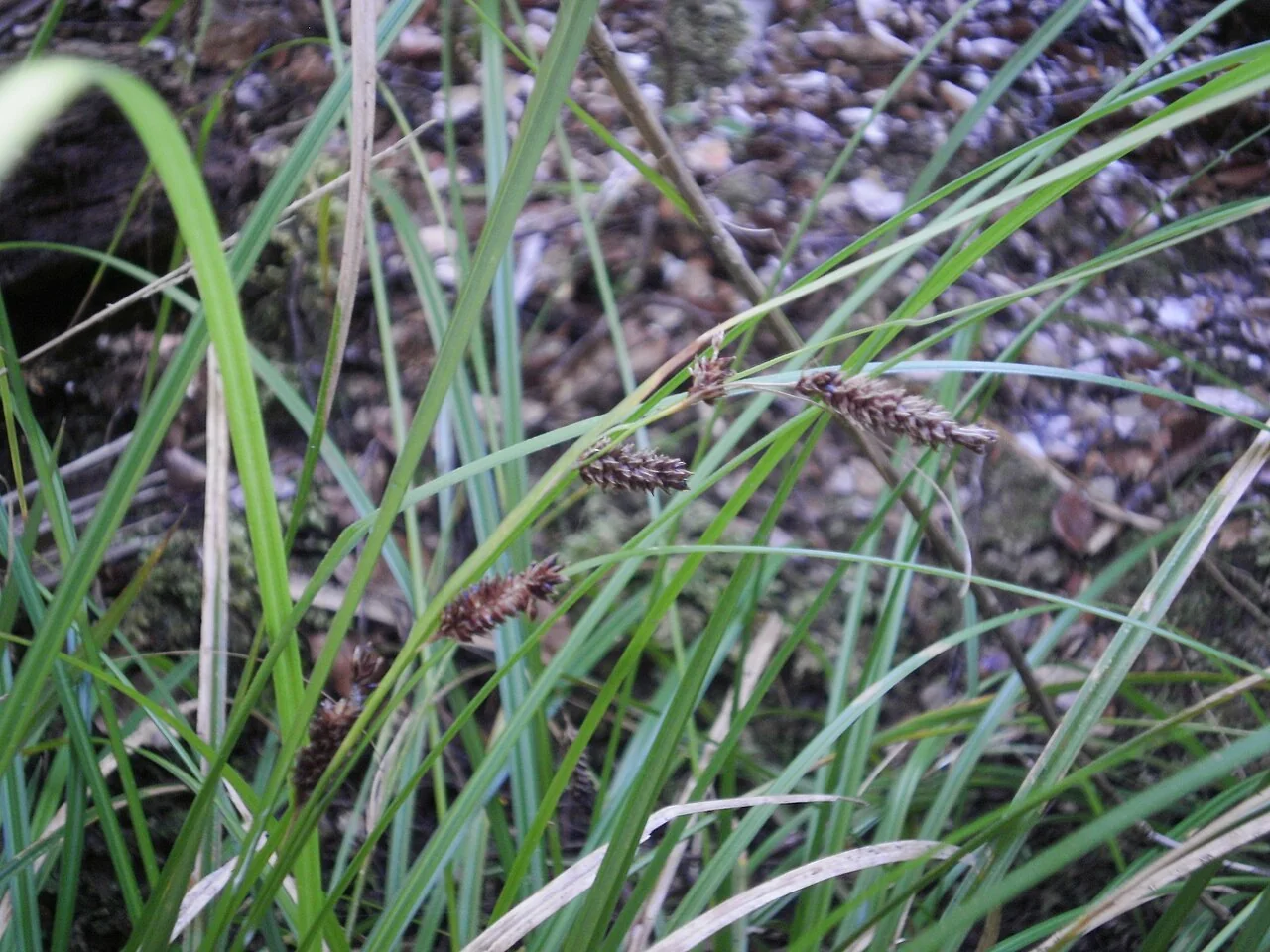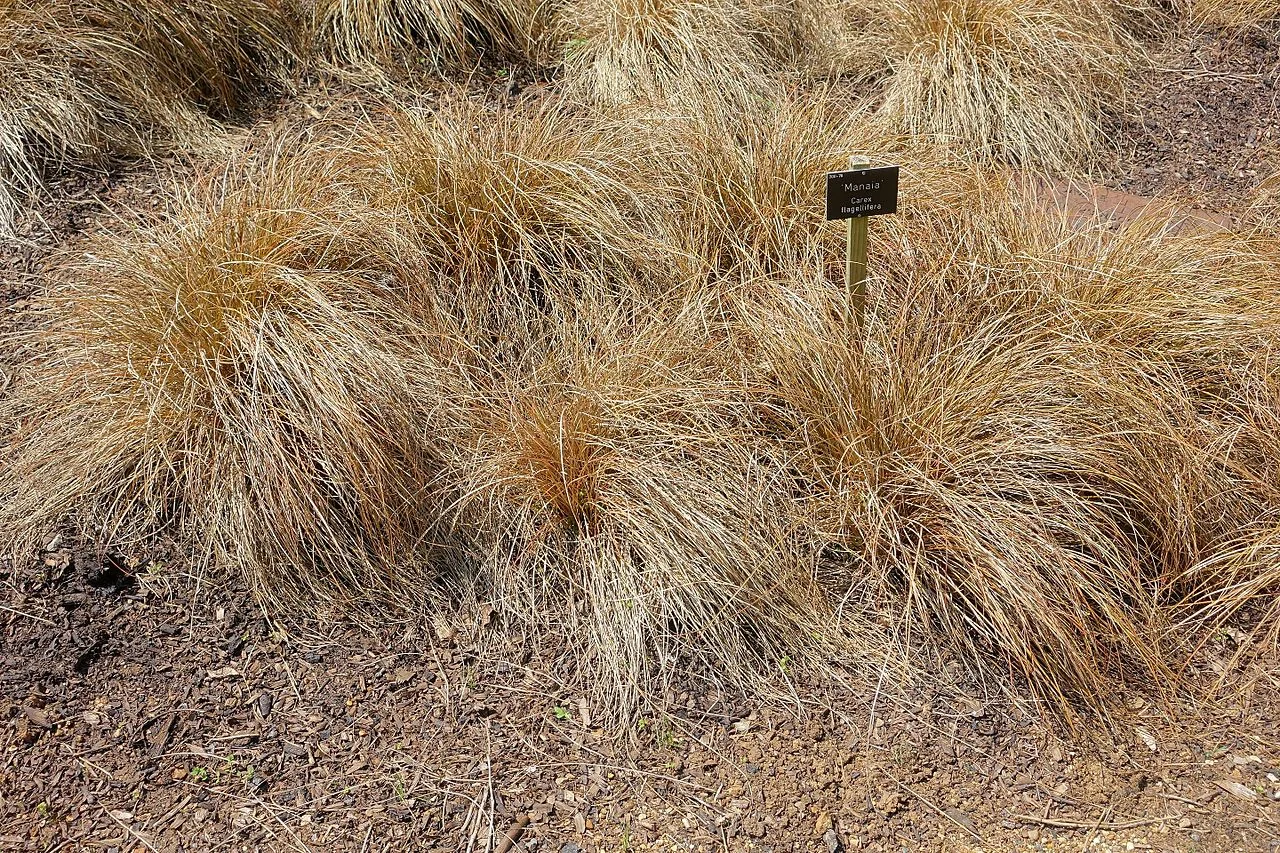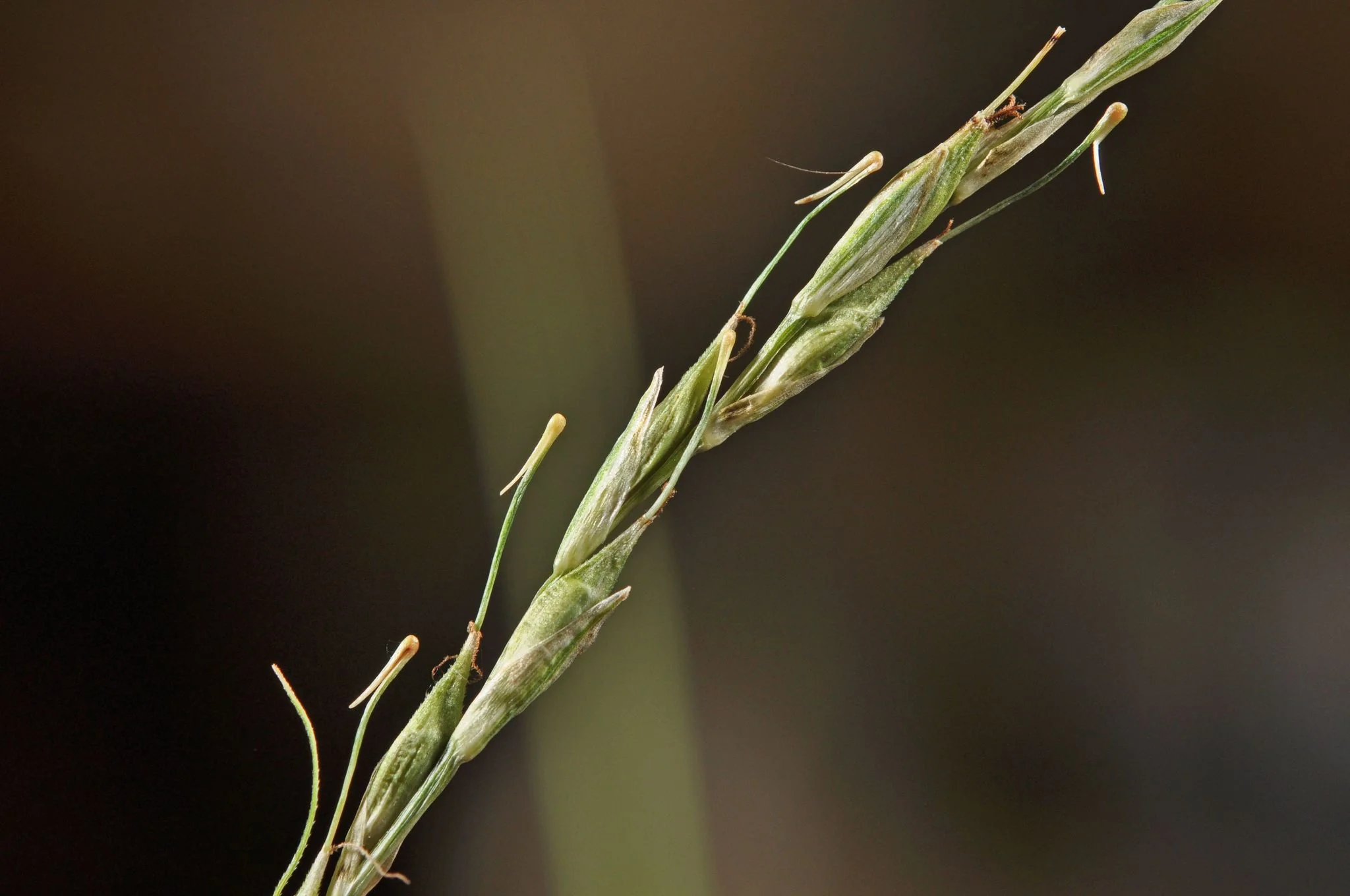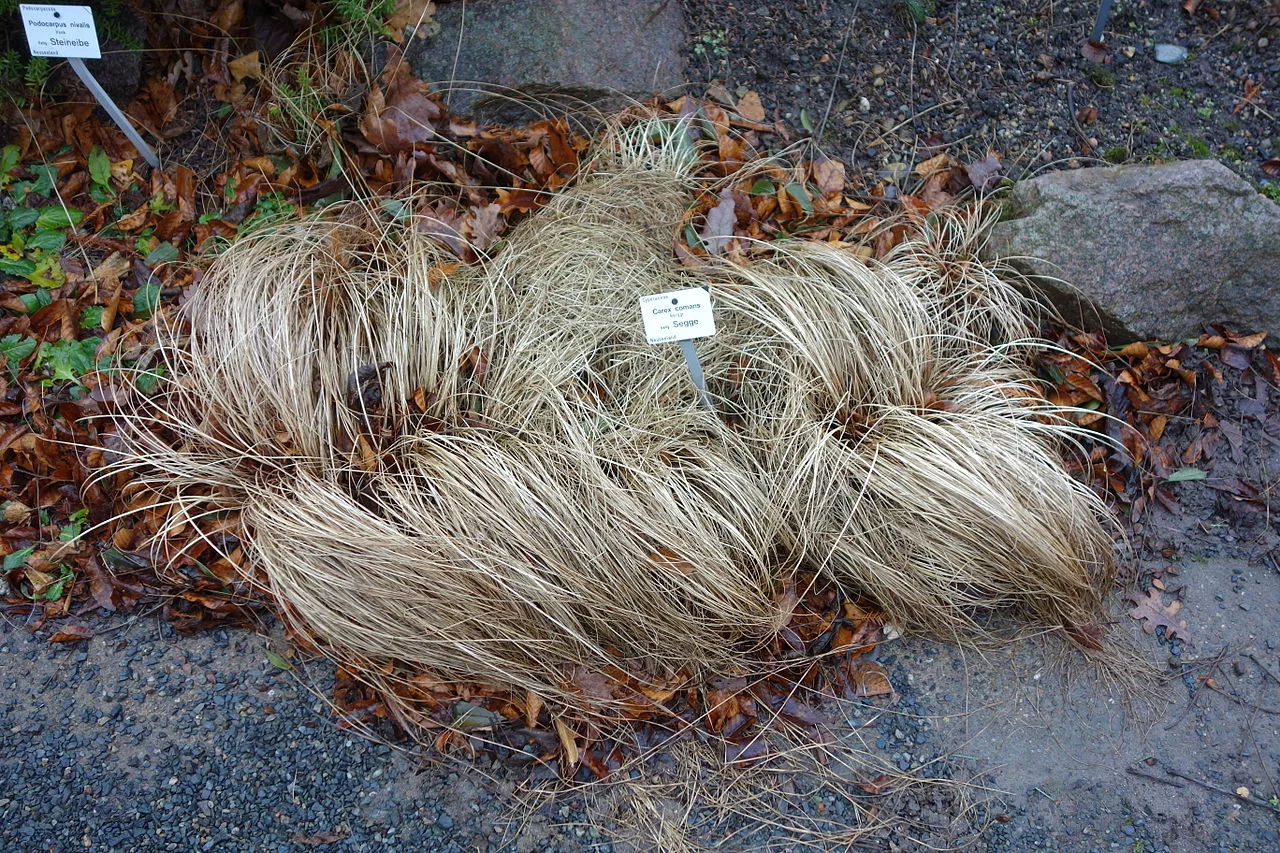
Frosted Curls Sedge
Carex comans
Explore more NZ native plant guides in our index .
Introduction
About Frosted Curls Sedge
Carex comans , commonly known as Frosted Curls Sedge or New Zealand Hair Sedge, is an exceptionally graceful native sedge endemic to New Zealand that has become one of the world's most popular ornamental grasses due to its distinctive mop-like appearance and flowing texture. This remarkable species forms dense, weeping clumps of incredibly fine, hair-like foliage that cascades elegantly to create a mesmerizing "frosted" or "waterfall" effect that shimmers and dances in the slightest breeze. The species epithet "comans" is Latin for "having a tufted or hair-like crown," perfectly describing its extraordinary form. Available in several stunning cultivars including silvery-green 'Frosted Curls', bronze-red forms, and seasonal colour-changing varieties that transition from pale green in spring to sandy autumn tones and bronze winter hues, this relatively short-lived but easily propagated sedge offers year-round ornamental appeal in gardens worldwide.

Plant Description
Carex comans , commonly known as Frosted Curls Sedge or New Zealand Hair Sedge, is a graceful evergreen perennial sedge endemic to New Zealand. It forms dense, weeping clumps of incredibly fine, hair-like foliage that cascades elegantly, creating a mesmerizing "frosted" or "waterfall" effect. The leaves can vary in colour from silvery-green to pale yellow-green, or even reddish-brown or bronze, often changing with the seasons. This sedge typically grows 25-60 cm tall and is highly valued for its ornamental qualities, providing year-round visual interest in gardens.
Quick Facts
| Scientific Name | Carex Comans |
|---|---|
| Height | 15-20 m |
| Spread | 3-5 m |
| Water Needs | Moderate |
| Light | Full sun to part shade |
| Frost Tolerance | Moderate |
| Salt Tolerance | Moderate |
| Growth Rate | Medium |
| Lifespan | Long |
Climate Best Suited to
Carex comans naturally inhabits New Zealand's temperate pastures, roadside margins, and open grassland areas where it has adapted to a wide range of conditions from moist to periodically dry soils. This hardy endemic sedge demonstrates remarkable climate adaptability, thriving across USDA zones 7-10 and tolerating both heat and humidity while maintaining excellent drought tolerance once established. Its natural resilience in New Zealand's variable climate conditions, combined with its tolerance for poor soils and ability to naturalize through self-seeding, makes it exceptionally versatile for cultivation in diverse global garden settings from Mediterranean climates to temperate maritime regions.
Regional Suitability
| Whangārei | Ideal |
| Auckland | Ideal |
| Hamilton | Suitable |
| Rotorua | Suitable |
| Tauranga | Ideal |
| Gisborne | Ideal |
| New Plymouth | Ideal |
| Whanganui | Ideal |
| Palmerston North | Suitable |
| Napier | Ideal |
| Wellington | Ideal |
| Nelson | Ideal |
| Christchurch | Suitable |
| Dunedin | Suitable |
| Invercargill | Suitable |
| City | Climate Suitability |
|---|
Habitat
Natural Distribution
Carex comans , commonly known as Frosted Curls Sedge or New Zealand Hair Sedge, is a graceful native sedge endemic to New Zealand, found across the North, South, and Stewart Islands. Its natural habitat includes a variety of environments, typically characterized by free-draining soils.
It can be found in damp tussock grassland, alongside bush tracks, and on river flats. This sedge also thrives under scrub, within tall forests, or in relatively open, sparsely vegetated areas. Its range extends from coastal to subalpine regions, demonstrating its adaptability to diverse conditions. In its native country, it is also commonly observed in pastures and along roadsides, and often naturalizes in urban areas.
Carex comans is adaptable and can tolerate a wide range of conditions, but it does not fare well in permanently waterlogged soils. It prefers well-drained soils, which can range from sandy to loamy, and grows best in full sun to partial shade.
Plant Conservation
Carex comans is currently not considered threatened and maintains stable populations across its native range in New Zealand. This endemic sedge is found on North, South, and Stewart Islands, demonstrating good adaptability to diverse environmental conditions from coastal to subalpine regions.
The species benefits from being commonly available from mainstream and specialist native plant nurseries, indicating healthy cultivation populations that reduce pressure on wild stocks. Its ability to naturalize in urban areas and tolerate a wide range of conditions has contributed to its conservation stability, though this adaptability occasionally leads to invasive tendencies in some managed landscapes.
An important conservation consideration involves taxonomic clarity around the popular 'Frosted Curls' cultivar, which in its original form is actually the closely related C. fretalis . This related species faces conservation challenges from habitat loss and is restricted to specific coastal areas in Southland and Stewart Island, highlighting the importance of accurate species identification in conservation efforts.
While C. comans itself remains stable, ongoing monitoring under the New Zealand Threat Classification System ensures continued assessment of population trends. The species' cultural significance as Maurea in Māori tradition and its popularity in both native and international horticulture contribute to conservation awareness and appreciation of New Zealand's unique sedge flora.
Growing Requirements
Soil Requirements
White maire (Nestegis lanceolata) is remarkably adaptable to different soil conditions, thriving in well-drained environments. It can tolerate a variety of soil types, from sandy to loamy, and prefers a neutral to slightly acidic pH. Good drainage is crucial to prevent root rot, ensuring healthy growth and development.
- Tolerates a wide range of soil types from clay to sandy
- Prefers well-draining soils but can handle occasional waterlogging
- Thrives in moderately fertile soils but will grow in poor soils too
- Can tolerate slightly acidic to slightly alkaline pH
- Handles coastal conditions including salt spray
Light Requirements
White maire (Nestegis lanceolata) thrives in a variety of light conditions, from full sun to partial shade. Optimal growth and flowering are typically achieved in locations receiving ample sunlight throughout the day. However, it can also tolerate some shade, especially in hotter climates, where it benefits from protection during the most intense afternoon sun.
- Full sun for optimal growth and form
- Can tolerate partial shade but may develop a leggier form
- At least 6 hours of direct sunlight daily is ideal
- Northern or eastern exposures work well in garden settings
Water Requirements
Once established, White maire (Nestegis lanceolata) is remarkably drought-tolerant, requiring minimal supplemental watering. During its establishment phase, consistent moisture is crucial to encourage strong root development. Mature plants can withstand dry periods, but regular watering during prolonged droughts will promote healthier growth and more abundant flowering.
- Moderate watering during establishment (first 1-2 years)
- Drought-tolerant once established
- Can handle periods of soil saturation
- Reduce watering in winter when growth slows
- Signs of overwatering include yellowing leaves and crown rot
Planting Guide
-
When to Plant
Plant in autumn or spring.
-
Site Preparation
Choose a sunny or partially shaded site with moist, well-drained soil.
-
Planting and Aftercare
Dig a hole twice the width of the pot. Place the plant in the hole and backfill with soil. Water well and apply a layer of mulch.
Ecological Significance
Carex comans , commonly known as Frosted Curls Sedge or New Zealand Hair Sedge, is an evergreen perennial sedge endemic to New Zealand. It plays several ecological roles within its native habitats, contributing to the health and biodiversity of various ecosystems.
- Soil Stabilization: Like other Carex species, Carex comans has dense, fibrous root systems that are highly effective in preventing erosion and stabilizing soil, particularly in its preferred habitats of free-draining soils along river flats, bush tracks, and open grasslands. Its tussock-forming growth habit further enhances bank stabilization.
- Habitat and Food Source: Sedges, including Carex comans , provide crucial habitat and food sources for various wildlife. Their foliage offers shelter for insects and small mammals. The seeds of native sedges are consumed by a wide range of birds, such as ducks, grouse, wild turkeys, sandpipers, and sparrows, and also serve as a food source for caterpillars and small mammals. They provide an early food source in spring, supporting the initial stages of many food webs.
- Biodiversity Contribution: Carex comans contributes to overall biodiversity within ecosystems by adding structural complexity and providing resources for various trophic levels.
- Water Filtration and Nutrient Cycling: The genus Carex also plays a role in water filtration and nutrient cycling, helping to maintain water quality and soil fertility in its environment.
- Indicator Species: Many Carex species are indicators of wetland health. Although Carex comans prefers well-drained soils and avoids permanently waterlogged conditions, its presence in damp areas like streambanks and pond margins indicates its role in these riparian environments.
- Reproduction and Dispersal: Reproduction occurs through seeds, which are dispersed by granivory (seed consumption by animals) and wind, and also by division of established plants. This efficient dispersal mechanism allows it to colonize new suitable habitats and maintain its widespread distribution.
Uses and Significance
Garden Uses
- Specimen tree for visual impact
- Suitable for native gardens and restoration projects
- Enhances native garden aesthetics and biodiversity
- Provides architectural accent with its unique structure
- Effective for erosion control on slopes and banks
Ecological Value
Ecologically, White maire (Nestegis lanceolata) plays a crucial role in supporting native ecosystems. Its fruits are a food source for birds, especially the kererū, contributing to the local biodiversity and food web.
- Provides a vital food source for native birds, especially the kererū
- Offers habitat and nesting sites for various fauna
- Contributes to soil stabilization and nutrient cycling
- Forms natural shelter belts, protecting other species
Cultural Significance
Traditional Uses and Values
While not as widely documented for traditional Māori uses as some other native plants, Frosted Curls Sedge ( Carex comans ) was part of the unique high-country landscape and would have been known to local iwi. Its distinctive appearance would have made it a recognizable feature of the dry interior regions of the South Island.
Landscaping Uses
Garden Design Applications
Carex comans , also known as Frosted Curls Sedge or New Zealand Hair Sedge, is a versatile ornamental grass widely used in landscaping for its fine-textured, weeping foliage and low-maintenance characteristics. Its unique cascading habit and various colour forms make it a popular choice for diverse garden designs.
- Mass Plantings: It is excellent for creating spectacular effects and a natural tussock land appearance when planted en masse. It can be used in large areas under trees to add texture and contrast, creating a flowing, dynamic landscape.
- Beds and Borders: Carex comans serves as a graceful accent plant, an effective edging plant, or can be placed in the front of borders to define edges and add visual interest with its unique form.
- Container Plantings: It performs exceptionally well in containers, either as a standalone plant or as part of a mixed planting. Its cascading foliage can spill over the edges, adding character and texture to patios, balconies, and courtyards.
- Rock Gardens: Its ability to thrive in well-drained soils makes it suitable for rock gardens, where it can be tucked between rocks to soften hard edges and add a natural element.
- Water Features: Carex comans is ideal for planting along streambanks, pond margins, or water garden peripheries, where its foliage can be reflected in the water for added visual interest and a serene effect.
- Ground Cover: It can be mass planted as a ground cover, particularly on banks or slopes, where its dense growth helps with erosion control. In some contexts, it can even be considered as a lawn substitute for low-traffic areas.
- Winter Interest: As an evergreen perennial, it provides year-round appeal. The bronze forms, in particular, offer valuable colour and texture during the winter months, adding interest when many other plants are dormant.
- Modern and Low-Maintenance Designs: Its unique foliage and flowing texture make it a popular choice for modern landscapes, city, and courtyard gardens. It is favoured for its low-maintenance requirements, making it suitable for busy gardeners.
- Specialized Gardens: It can be incorporated into woodland gardens, meadow gardens, and around outdoor living areas like pools and barbecue areas, enhancing the natural beauty of these spaces.
Seasonal Care Calendar
Spring
In spring, White maire (Nestegis lanceolata) begins its active growth phase. New foliage emerges, and it's an ideal time for planting new specimens or propagating. Ensure adequate moisture and monitor for early signs of pests.
- New growth begins with fresh foliage development
- Apply a balanced, slow-release fertilizer if desired
- Excellent time for planting new specimens or dividing offsets
- Monitor for new pest activity and address promptly
Summer
Summer is the peak growing season for White maire (Nestegis lanceolata), often accompanied by flowering. Consistent watering is important, especially for young plants, to support vigorous growth and prevent stress during dry periods.
- Flowering typically occurs in early to mid-summer (November-January)
- Water young trees regularly during extended dry periods
- Avoid heavy pruning during the active growing season
Autumn
During autumn, White maire (Nestegis lanceolata) prepares for the cooler months. Fruits or berries develop, providing food for native birds. It's also a good time for planting and general garden cleanup.
- Fruits or berries develop and ripen (December-February), attracting birds
- Natural leaf shedding occurs as part of its growth cycle
- Good time for planting new specimens to establish before winter
- Clean up fallen leaves if a tidy appearance is desired
Winter
Winter is generally a dormant period for White maire (Nestegis lanceolata). Minimal care is required, though young plants may benefit from protection in colder regions. This is an opportune time for any necessary structural pruning.
- Generally dormant with minimal growth activity
- No special winter protection needed in most mild climates
- Suitable time for structural pruning if required
- Fallen leaves can be left as mulch or removed for tidiness
When to Prune and How Much
White maire (Nestegis lanceolata) generally requires minimal pruning to maintain its natural form and health. Pruning should focus on removing dead or damaged growth and shaping the plant as needed.
- Remove dead, damaged, or diseased branches at any time of year
- Light formative pruning when young helps establish good structure
- To create a multi-trunked specimen, cut the main stem to encourage branching
- Fallen leaves can be removed for a tidier appearance, or left as natural mulch
- If necessary, lower branches can be removed to create clearance underneath
- Major pruning is best done in late winter to early spring before new growth
Always use clean, sharp tools for pruning to minimize the risk of disease and ensure clean cuts. The plant often responds well to pruning with vigorous new growth, contributing to a fuller, healthier appearance.
How to Grow Frosted Curls Sedge
From Division
Division represents the most practical and successful propagation method for Frosted Curls Sedge, taking advantage of this distinctive ornamental grass \'s natural clumping habit while addressing its relatively short lifespan of 3-5 years through regular rejuvenation. This popular New Zealand native forms dense, cascading clumps of fine, hair-like foliage that creates a striking frosted appearance, making it highly valued in contemporary landscape design. The optimal timing for division is during spring or autumn when the plant is either emerging from or entering dormancy, providing divided sections with favorable conditions for rapid establishment before facing environmental stress. Regular division every 2-3 years is beneficial not only for propagation but also for maintaining plant vigor and the distinctive silvery-green coloration that makes this species so valuable in ornamental plantings. Begin by carefully lifting the entire clump using a garden fork, working gently around the perimeter to preserve the shallow but extensive fibrous root system that provides drought tolerance once established. Frosted Curls Sedge develops a relatively shallow root mass compared to other sedges, making it easier to handle during division but requiring careful attention to preserve root integrity. Once lifted, examine the clump structure to identify natural division points where separate crowns have developed, typically visible as distinct tufts of the characteristic fine, hair-like foliage. The shallow, fibrous root system divides easily with minimal tools, often separating naturally along crown boundaries with gentle handling. Use clean hands or small tools to separate divisions, ensuring each section includes both healthy roots and sufficient crown material to support the plant's distinctive cascading growth habit. Divisions can be quite small as this species establishes readily, with even small sections containing 2-3 growing points capable of developing into full-sized clumps within one growing season. Replant divisions immediately at the same depth they were previously growing, spacing them 40-60cm apart to accommodate their mature spread and natural arching habit. Choose locations with full sun to partial shade and well-draining soil, as this species thrives in a wide range of conditions but performs best with good drainage and protection from extreme moisture fluctuations. Water thoroughly after planting to settle soil around roots, then maintain moderate moisture during establishment while avoiding waterlogged conditions that can damage the fine root system.
From Seeds
Seed propagation offers an excellent and economical method for growing Frosted Curls Sedge, particularly valuable for large-scale plantings and taking advantage of this species' prolific self-seeding habit under favorable garden conditions. This adaptable ornamental grass produces abundant viable seeds through inconspicuous flower spikes that develop during late summer to autumn, providing multiple opportunities for seed collection during the extended fruiting season. The species' natural tendency to self-seed readily under satisfactory conditions demonstrates the viability and ease of seed propagation, with established plants often producing volunteer seedlings that can be transplanted or allowed to naturalize in suitable locations. Collect seeds from the inconspicuous flower spikes during late summer to autumn when the seeds have matured and are beginning to disperse naturally, cutting entire seed heads with clean secateurs and placing them in paper bags to complete drying. Seeds maintain good viability when collected fresh and can be stored for short periods in cool, dry conditions if immediate sowing is not possible. The self-seeding habit means established plants often produce volunteer seedlings around the parent plant, providing ready sources of new plants that can be carefully lifted and transplanted to desired locations. Sow fresh seeds in autumn on a well-draining propagation mix that provides consistent moisture without becoming waterlogged, using a combination of quality seed-raising mix with added perlite or coarse sand for optimal drainage. Sow seeds thinly on the surface of firm, moist growing medium, covering lightly with a thin layer of fine sand or vermiculite as they benefit from some light during germination. Place seed trays in a protected location with bright, indirect light and consistent cool temperatures throughout winter, allowing natural stratification to break dormancy mechanisms. Maintain consistent moisture without waterlogging throughout the germination period, which typically occurs in spring as temperatures begin to warm and daylight hours increase. Young seedlings develop relatively quickly compared to other sedges, forming the characteristic fine, hair-like foliage within their first growing season while establishing the fibrous root systems that provide drought tolerance. Seedlings can be transplanted when they have developed sufficient root systems and foliage mass, typically after 6-8 weeks of growth under favorable conditions. This method is particularly effective for creating naturalistic plantings where the slight variation in foliage characteristics adds to the overall garden effect.
From Natural Regeneration
Natural regeneration provides the most effortless propagation method for Frosted Curls Sedge, taking advantage of the species' prolific self-seeding habit and relatively short lifespan to create naturally sustainable plantings that require minimal intervention. This approach is particularly valuable for naturalistic garden designs where the goal is to establish self-maintaining plant communities that regenerate over time without ongoing propagation effort. Frosted Curls Sedge naturally produces abundant seeds that germinate readily in suitable conditions, with new seedlings often appearing around established plants during favorable seasons. The species' relatively short lifespan of 3-5 years is compensated by its vigorous self-seeding habit, creating a natural cycle of plant replacement that maintains continuous coverage over time. To encourage natural regeneration, establish initial plantings in locations with suitable growing conditions including well-draining soil, adequate moisture during establishment, and protection from extreme environmental stress. Allow seed heads to remain on plants through autumn and winter rather than removing them for tidiness, as this provides the seed source essential for natural regeneration to occur. Create suitable microsites for seedling establishment by maintaining areas of bare or lightly mulched soil around established plants where seeds can germinate without excessive competition from other vegetation. Young seedlings typically appear in spring following favorable winter conditions, establishing themselves in gaps and open areas around parent plants where growing conditions are suitable. Monitor emerging seedlings and provide protection from extreme conditions during their first growing season, though minimal intervention is typically required as naturally regenerated plants are often well-adapted to local growing conditions. Thin excessive seedlings if overcrowding occurs, transplanting surplus plants to expand plantings or sharing with other gardeners interested in this attractive ornamental species. Allow some seedlings to mature in place to continue the natural regeneration cycle, creating sustainable plantings that provide ongoing landscape value with minimal ongoing maintenance. This method is particularly effective in suitable climate zones where the species thrives and can establish the conditions necessary for long-term natural regeneration, creating dynamic plantings that evolve over time while maintaining the distinctive frosted appearance that makes this sedge so valuable in contemporary garden design.
Pests and Diseases
Naturally Hardy
Generally pest and disease free.
Watch for scale and fungal leaf spots; improve airflow and avoid over-watering to limit disease pressure.
Bonus Tip
Expert Growing Advice
For the most dramatic "frosted" effect, plant Carex comans 'Frosted Curls' where it can be backlit by the sun. The fine, silvery-green foliage will catch the light and appear to glow, creating a stunning visual display.
